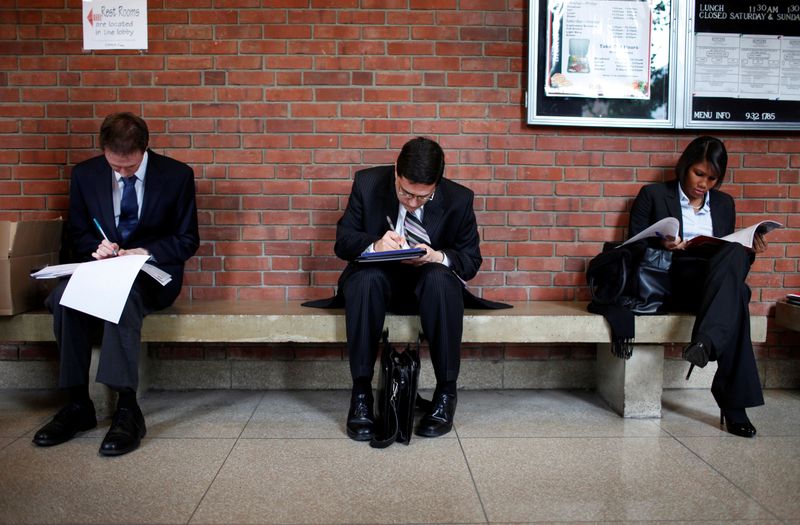U.S. job growth seen smallest in nearly two years in October, unemployment rate up
2022.11.04 00:40
[ad_1]
3/3

© Reuters. FILE PHOTO: Job seekers prepare for career fair to open at Rutgers University in New Brunswick, New Jersey, January 6, 2011. REUTERS/Mike Segar/Files
2/3
By Lucia Mutikani
WASHINGTON (Reuters) – U.S. employers likely hired the fewest workers in nearly two years in October and increased wages at a moderate pace, suggesting some loosening in labor market conditions, which would allow the Federal Reserve to shift towards smaller interest rates increases starting in December.
The Labor Department’s closely watched employment report on Friday is also expected to show unemployment ticking up to 3.6% from 3.5% in September. The Fed on Wednesday delivered another 75-basis-point interest rate hike and said its fight against inflation would require borrowing costs to rise further.
But the central bank signaled it may be nearing an inflection point in what has become the fastest tightening of monetary policy in 40 years.
“The labor market is basically OK, but it does seem to be slowing,” said Guy Berger, principal economist at LinkedIn
in San Francisco. “The Fed is going to try to thread the needle where they slow down the labor market enough to put downward pressure on wages and inflation, without causing a recession.”
Nonfarm payrolls likely increased by 200,000 jobs last month after rising 263,000 in September, according to a Reuters survey of economists. That would be the smallest gain since December 2020, when payrolls declined under an onslaught of COVID-19 infections. Estimates ranged from 120,000 to 300,000.
Employment gains were probably almost evenly distributed among industry sectors, in line with recent patterns, with the leisure and hospitality industry leading the way. Leisure and hospitality employment remains below its pre-pandemic level by at least a million jobs. Interest rate-sensitive industries like financial activities as well as transportation and warehousing probably shed jobs as they did in September. Government payrolls are seen declining further.
Hurricane Ian is expected to have put a small dent in payrolls. The storm slammed into Florida in late September and boosted unemployment claims in mid-October, when the government surveyed businesses for last month’s employment report.
“Hurricane Ian should have at least some downward impact on nonfarm payrolls,” said Lou Crandall, chief economist at Wrightson ICAP (LON:) in Jersey City. “We have lowered our forecast slightly to show an increase of 150,000 (from 200,000) on the assumption that at least some workers were sidelined in the areas hit hardest by the hurricane.”
BACKFILLING POSITIONS
Job growth has remained solid even as domestic demand has softened amid higher borrowing costs because of companies replacing workers who would have left. But with recession risks mounting, this practice could end soon. A survey from the Institute for Supply Management on Thursday found some service industry companies “are holding off on backfilling open positions,” because of uncertain economic conditions.
Still, the labor market remains tight, with 1.9 job openings per unemployed person at the end of September.
Average hourly earnings are forecast to have increased 0.3%, matching September’s gain. But there is a risk of an upside surprise because of Hurricane Ian as well as a calendar quirk. According to Wrightson ICAP’s Crandall, storms and other events that keep people away from work during the payrolls survey week can artificially raise the reported level of hourly earnings.
The government surveys businesses and households during the during the week that includes the 12th day of the month.
“The payroll survey week included the 15th of the month, which tends to bias the month/month change higher, since wage increases secured by those workers paid at mid-month and month-end rather than bi-weekly are more likely to have been captured,” said Kevin Cummins (NYSE:), chief U.S. economist at NatWest Markets in Stamford, Connecticut.
Stripping out any distortions from the weather and calendar quirk, wage growth is cooling. Average hourly earnings are forecast to have increased 4.7% year-on-year in October after rising 5.0% in September. Other wage measures have also come off the boil, which bodes well for inflation.
“We believe we’ve seen wage growth peak,” said Michelle Green, principal economist at Prevedere in Columbus, Ohio. “So while we will continue to see year-over-year growth in average hourly earnings across all private sector employees, the velocity of that growth really is starting to slow down.”
[ad_2]
Source link








